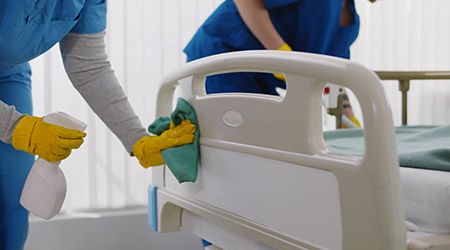Editor’s note: This is the first part of a two-part column. Read part two here.
Environmental surfaces abound in every indoor environment. These surfaces get loaded with fomites, which are nonliving material, any object or substance other than food that harbors or carries infectious organisms.
As environmental services staff in healthcare facilities goes about the daily routine of spraying and wiping, managers might wonder, “Are we cleaning and disinfecting those environmental surfaces the right way? Am I confident that our processes, training, tools and chemicals are delivering the best outcome: a safe, clean and disinfected space?”
Let’s look at some of the factors that impact the ability to consistently deliver on the promise that the building will be safer because workers have done a good job of cleaning:
- Not using the proper procedures and best practices for this segment of the cleaning business
- The range of surfaces needing cleaning and disinfection
- A lack of education and easily understood training for housekeepers whose first language is not English.
Let me break it down this way: There are best practices for cleaning and disinfection. For healthcare, the Association for the Healthcare Environment (AHE) and the IEHA, a division of ISSA, have many best practices and procedures that managers can purchase.
On the surface
Buildings and campuses have a variety of environmental surfaces that must be kept clean and disinfected. Starting at the front door, workers might have to clean the concrete sidewalk outside the entrance, glass windows and doors, brass handles on doors, and the entrance carpet matting. Within the first 15 feet, rough concrete must be regularly cleaned a certain way to remove gum, litter, cigarette butts, and stains. Glass doors and windows must be kept free of spots, smudges, film, and streaks.
But workers cannot use the same cleaning practices to clean glass that they use to clean concrete. They need to disinfect brass handles and polish them to a high shine — two different cleaning procedures with the accompanying chemicals and cloths. Then the carpet mat must be vacuumed and kept free of litter, gum, and spots. Often, the soiled mat must be exchanged for a clean one.
You get the picture. We have barely gotten into the building, and you have a variety of surfaces that workers must keep clean and disinfected using different processes and tools and possibly different job classifications while doing the work on different shifts and different frequencies of cleaning. They are not the same and cannot be maintained in the same manner. That fact makes cleaning and disinfecting a huge challenge.
Language matters
It is a well-known and accepted fact that more than one-half of the cleaning employees in hospitals, hotels, office buildings and public facilities such as airports, shopping malls and schools are not natural born citizens. They come from Eastern and Western Europe, the former Soviet Union, Southeast Asia, Korea, Mexico, Central America, and many other regions of the world.
Employees with different religions, backgrounds and cultures make up environmental services departments. As one might guess, with many of these employees, English is not their first language.
For managers with workers in their departments who do not speak English, have you translated department policies, chemical labels, procedures, work rules, and training materials into their native languages?
If I went to live and work in another country where English was not spoken and understood, I would understand how those workers feel here in the United States. On the other hand, would I expect all those things I just mentioned to be available in English? Or would I be expected to learn the language of the country I had chosen to live in?
As a leader in the environmental services department, managers need to understand the dynamics of getting the job done with the workforce, retaining the best workers, and building a team that delivers daily. At the end of the day, the building has to be safe, clean, and disinfected.
In the second part of this column, we will look at more factors in answering the question, “Are we cleaning and disinfecting environmental surfaces the right way?”
J. Darrel Hicks, BA, MESRE, CHESP, Certificate of Mastery in Infection Prevention, is the past president of the Healthcare Surfaces Institute. Hicks is a nationally recognized subject matter expert in infection prevention and control as it relates to cleaning. He is the owner and principal of Safe, Clean and Disinfected. His enterprise specializes in B2B consulting, webinar presentations, seminars and facility consulting services related to cleaning and disinfection. He can be reached at darrel@darrelhicks.com. Learn more at www.darrelhicks.com.

 Building Sustainable Healthcare for an Aging Population
Building Sustainable Healthcare for an Aging Population Froedtert ThedaCare Announces Opening of ThedaCare Medical Center-Oshkosh
Froedtert ThedaCare Announces Opening of ThedaCare Medical Center-Oshkosh Touchmark Acquires The Hacienda at Georgetown Senior Living Facility
Touchmark Acquires The Hacienda at Georgetown Senior Living Facility Contaminants Under Foot: A Closer Look at Patient Room Floors
Contaminants Under Foot: A Closer Look at Patient Room Floors Power Outages Largely Driven by Extreme Weather Events
Power Outages Largely Driven by Extreme Weather Events